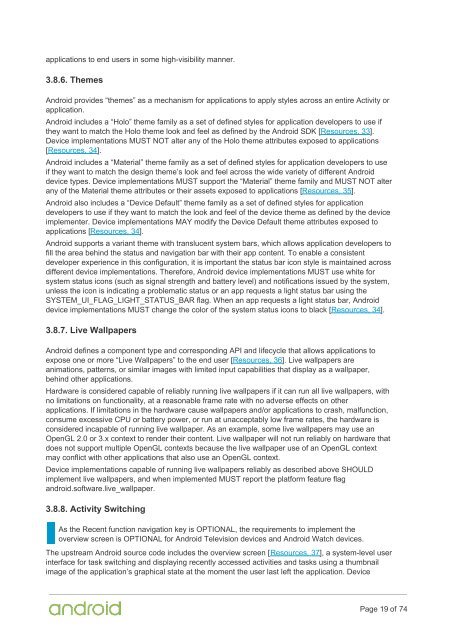Compatibility Definition
2f44OdUf0
2f44OdUf0
You also want an ePaper? Increase the reach of your titles
YUMPU automatically turns print PDFs into web optimized ePapers that Google loves.
applications to end users in some high-visibility manner.<br />
3.8.6. Themes<br />
Android provides “themes” as a mechanism for applications to apply styles across an entire Activity or<br />
application.<br />
Android includes a “Holo” theme family as a set of defined styles for application developers to use if<br />
they want to match the Holo theme look and feel as defined by the Android SDK [Resources, 33].<br />
Device implementations MUST NOT alter any of the Holo theme attributes exposed to applications<br />
[Resources, 34].<br />
Android includes a “Material” theme family as a set of defined styles for application developers to use<br />
if they want to match the design theme’s look and feel across the wide variety of different Android<br />
device types. Device implementations MUST support the “Material” theme family and MUST NOT alter<br />
any of the Material theme attributes or their assets exposed to applications [Resources, 35].<br />
Android also includes a “Device Default” theme family as a set of defined styles for application<br />
developers to use if they want to match the look and feel of the device theme as defined by the device<br />
implementer. Device implementations MAY modify the Device Default theme attributes exposed to<br />
applications [Resources, 34].<br />
Android supports a variant theme with translucent system bars, which allows application developers to<br />
fill the area behind the status and navigation bar with their app content. To enable a consistent<br />
developer experience in this configuration, it is important the status bar icon style is maintained across<br />
different device implementations. Therefore, Android device implementations MUST use white for<br />
system status icons (such as signal strength and battery level) and notifications issued by the system,<br />
unless the icon is indicating a problematic status or an app requests a light status bar using the<br />
SYSTEM_UI_FLAG_LIGHT_STATUS_BAR flag. When an app requests a light status bar, Android<br />
device implementations MUST change the color of the system status icons to black [Resources, 34].<br />
3.8.7. Live Wallpapers<br />
Android defines a component type and corresponding API and lifecycle that allows applications to<br />
expose one or more “Live Wallpapers” to the end user [Resources, 36]. Live wallpapers are<br />
animations, patterns, or similar images with limited input capabilities that display as a wallpaper,<br />
behind other applications.<br />
Hardware is considered capable of reliably running live wallpapers if it can run all live wallpapers, with<br />
no limitations on functionality, at a reasonable frame rate with no adverse effects on other<br />
applications. If limitations in the hardware cause wallpapers and/or applications to crash, malfunction,<br />
consume excessive CPU or battery power, or run at unacceptably low frame rates, the hardware is<br />
considered incapable of running live wallpaper. As an example, some live wallpapers may use an<br />
OpenGL 2.0 or 3.x context to render their content. Live wallpaper will not run reliably on hardware that<br />
does not support multiple OpenGL contexts because the live wallpaper use of an OpenGL context<br />
may conflict with other applications that also use an OpenGL context.<br />
Device implementations capable of running live wallpapers reliably as described above SHOULD<br />
implement live wallpapers, and when implemented MUST report the platform feature flag<br />
android.software.live_wallpaper.<br />
3.8.8. Activity Switching<br />
As the Recent function navigation key is OPTIONAL, the requirements to implement the<br />
overview screen is OPTIONAL for Android Television devices and Android Watch devices.<br />
The upstream Android source code includes the overview screen [Resources, 37], a system-level user<br />
interface for task switching and displaying recently accessed activities and tasks using a thumbnail<br />
image of the application’s graphical state at the moment the user last left the application. Device<br />
Page 19 of 74


